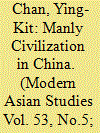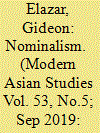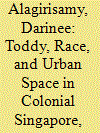|
|
|
Sort Order |
|
|
|
Items / Page
|
|
|
|
|
|
|
| Srl | Item |
| 1 |
ID:
167934


|
|
|
|
|
| Summary/Abstract |
UNESCO's founding in 1946 coincided with the resumption of hostilities between China's ruling Nationalist Party (KMT) and their Chinese Communist Party (CCP) rivals for power. The new international organization's officials in Paris and its representatives on the ground in China were thus forced to navigate a fractious and fluid set of national circumstances that would result in an ambiguous outcome in 1949, with regimes on the Chinese mainland and Taiwan both claiming to represent ‘China’. Although the KMT-led Republic of China continued to claim membership in UNESCO until the 1970s, the international organization nevertheless continued to operate within the People's Republic of China (PRC) for a number of years. Exploring the relationship between the issue of Chinese representation in UNESCO and the organization's on-the-ground presence from the mid-1940s through to the early 1950s, this article argues that domestic and international factors were inescapably intertwined in shaping the trajectory of Chinese relations with international organizations during this period. While CCP officials demonstrated a mixture of ideology and pragmatism, similar to their handling of foreign entities and groups present in the PRC after its founding, engagement with UNESCO was significantly shaped by the complexity and depth of the KMT's engagement with the international organization from its inception onwards. The CCP's relations with UNESCO underscore the extent to which the emerging Cold War—and China's place within it—was ultimately characterized by complexity and contingency.
|
|
|
|
|
|
|
|
|
|
|
|
|
|
|
|
| 2 |
ID:
167932


|
|
|
|
|
| Summary/Abstract |
Mao Zedong's historic swim in the Yangtze River on 16 July 1966, which heralded a new phase of the Cultural Revolution, was a carefully staged political performance and a notable example of body politics in Communist China. Beginning in the late 1950s, Mao began to broadcast the idea that he was a keen swimmer and to convince the masses to take up swimming. The swim was the climax of those efforts and an integral part of the Mao cult. Swimming in Mao's China offers a useful lens for understanding the close relationship between sports, the body, and politics. Swimming was a means for Mao to mobilize mass support for his political authority and a venue for the masses to practise and perform Maoism. This article examines the constructive process and meanings of Mao's swimming body, and the extent to which the bodies of the populace were regulated through the mass-swimming craze. Drawing on untapped archival materials related to mass swimming in Mao's China, this article argues that swimming both solidified and destabilized the Mao cult and became a venue through which political values were shaped, indoctrinated, contested, and repudiated.
|
|
|
|
|
|
|
|
|
|
|
|
|
|
|
|
| 3 |
ID:
167937


|
|
|
|
|
| Summary/Abstract |
Based on ethnographic fieldwork in rural Uttar Pradesh, this article contributes to debates on married women's relations with their natal kin. It compares women in ‘regional’ marriages (which conform to caste and community norms with a relatively small marriage distance) with women in ‘cross-regional’ marriages (those that cross caste, linguistic, and state boundaries, and entail long-distance migration). A focus on cross-regional marriage demonstrates how geographic distance cuts women off from vital structures of support. At the same time, even for regional brides, natal kin support is complicated and relative proximity does not guarantee support. Factors such as caste, class, poverty, the gender of children, notions of honour and shame, and stage in the life-course work together in complex ways to determine the duration and kind of support available. By focusing on marital violence, marital breakdown, and widowhood, the article demonstrates both the presence and the limits of natal kin support. The opportunities to draw on natal kin support vary for women, but its significance must not be understated as it alone provides women with the possibility of leaving their marriages, even if only temporarily. The article focuses on one form of women's agency, one that is constrained and highly dependent on relationships with others (mainly male kin). In such a context of economic and social dependency, natal kin support is an important—and perhaps the only—resource available in situations of marital crisis, and its absence leaves women in a particularly vulnerable position.
|
|
|
|
|
|
|
|
|
|
|
|
|
|
|
|
| 4 |
ID:
167933


|
|
|
|
|
| Summary/Abstract |
For over two centuries, prominent officials, literary figures, and intellectuals in China have paid special attention to the legacy of Shi Lang. Compared to many other historical figures, Shi Lang remains essential to our understanding of the cross-strait tension and the murky outlook for its future. Although the image of Shi Lang continues to mean different things to different individuals, to some degree, his significance to one particular community is also communicated to other communities. By analysing most of the previous appraisals and examinations of Shi Lang, we can reveal the historical narratives of this man as being continually under construction in a shifting and mutually reinforcing process. This article aims to examine the ways in which the legacy of Shi Lang has percolated throughout Chinese history, since the Qing dynasty, and also how it continues to function in the present day. It is fascinating to not only delineate how the story of Shi Lang has evolved as a legacy, but also to explore the rich variety of ways in which an individual or a community has adapted the narratives that make up the story of Shi Lang to suit the demands of different historical settings and perspectives.
|
|
|
|
|
|
|
|
|
|
|
|
|
|
|
|
| 5 |
ID:
167935


|
|
|
|
|
| Summary/Abstract |
This article builds on work by social and cultural historians of the Cold War such as Heonik Kwon and Masuda Hajimu by showing how three groups of Chinese actors helped create the locally specific reality of Chinese anticommunism in the Philippines during the late 1940s and early 1950s. It argues that, in a climate thick with Sinophobia and fears of communism, but largely devoid of actual Chinese Reds, anticommunism for the Chinese was only secondarily about rooting out subversives, ideological authenticity, and supporting Chiang Kai-shek's counterattack against mainland China. As a social phenomenon, it was primarily a diverse and flexible repertoire of practices, from crime to civic associationism, that Chinese elites and their challengers employed to bolster their reputations as anticommunists, enrich themselves, and pursue vendettas against their ‘communist’ enemies. By focusing on these practices of what I call ideological accommodation, the article intervenes in scholarship on the Chinese diaspora after the Second World War by showing that anticommunism was essential to how the overseas Chinese adapted to being resident ‘aliens’ in post-colonial Philippine society.
|
|
|
|
|
|
|
|
|
|
|
|
|
|
|
|
| 6 |
ID:
167930


|
|
|
|
|
| Summary/Abstract |
This article examines the transplantation of America's ‘manly’ civilization to 1920s Fujian, China, through the experiences of Harry R. Caldwell (1876–1970), a Methodist missionary whose hunting was central to his social evangelism. With his rifle, Caldwell protected Chinese villagers from man-eating tigers, taught them how to hunt tigers effectively, and enabled them to reconceptualize their relationships with tigers and nature. By engaging the American Museum of Natural History in his specimen collection and hunt for the mythical ‘Blue Tiger’, Caldwell introduced an economy of natural expeditions to the villagers who were hired to support the hunt. This article argues that Caldwell's experiences as both a missionary and a hunter in Fujian was an extension, or negotiation, of his rugged masculinity, which was fostered in his Tennessee home town. He identified as both a Christian and a hunter, and he did not see these parts of himself as distinct. A comparison between Caldwell and his contemporary, the British naturalist Arthur de Carle Sowerby (1885–1954), accentuates America's rugged masculinity by suggesting different national approaches to hunting and the growing professionalization of the naturalist.
|
|
|
|
|
|
|
|
|
|
|
|
|
|
|
|
| 7 |
ID:
167938


|
|
|
|
|
| Summary/Abstract |
This article draws together two studies: one that explores the intimate relationships of young slum-dwelling Dalit women in Mumbai and the other of young middle-class women in Baroda, Gujarat. Using an intersectional lens, we trace the ways that gendered ideals of respectability shape women's freedom of movement and relationships. The comparison produces new insights into the ways that class, caste, and location cut across gender to shape young women's lives in India. We argue that the distinctive positionings of the women structure the ways in which they react to gender norms and the means with which they strategize around them. Middle-class young women strike a ‘passive bargain’, upholding ideals of respectability by shoring up symbolic capital for a ‘good’ marriage and class privilege. The Dalit women show more active resistance to an ideal that they struggle to achieve, despite heavy control and surveillance over their movement and relationships. However, contrary to previous research, we show that both groups are beholden and lay claim to similar gendered and intimate ideals.
|
|
|
|
|
|
|
|
|
|
|
|
|
|
|
|
| 8 |
ID:
167931


|
|
|
|
|
| Summary/Abstract |
This article deals with the convergence of ethnicity and faith in the context of Christian Yunnan. Contemporary Evangelical missionaries working in Yunnan encourage the preservation of ethnic markers while attempting to create a form of ‘pristine faith’: a religiosity that severely limits the role of ethnicity in the construction of identity, emphasizing instead individualism and globalism—processes that may be beneficial for the Chinese state. My discussion here revolves around the distinction made by many Evangelical Christians in China between ‘true’ faith, based on an individual experience of salvation and rebirth, and ‘nominal’ faith, a traditional understanding of religion as an identity that is acquired at birth. Thus, minority Christians whose ancestors converted en masse prior to the 1949 revolution and retain a distinctly ethnic form of religiosity are often labelled ‘nominal’ by contemporary missionaries and converts. In contrast, the latter represent a faith that stems from personal experience and belongs to a global and transnational community, transcending the narrow limits of ethnic culture.
|
|
|
|
|
|
|
|
|
|
|
|
|
|
|
|
| 9 |
ID:
167929


|
|
|
|
|
| Summary/Abstract |
The political campaigns and events that comprised the US civil rights movement, as well as the urban race riots that coloured the 1960s, garnered widespread public attention and press coverage within the People's Republic of China (PRC). In the years between the Sino-Soviet Split in 1961 and the beginning of the Cultural Revolution in 1966, China strove to substantiate its commitment to US black liberation in three key respects: consistent news reporting, sentimental receptions of visiting black activists, and local gatherings that publicized up-to-date information on US anti-racist struggles and featured ordinary citizens sharing notes of empathy. This multidimensional Chinese engagement of US black freedom struggles helped to cement both intra-national and international solidarities. The party state, its mouthpieces, and everyday students and workers echoed Mao Zedong's dictum that racial discrimination was a matter of class struggle. Embedded within their observations was a critical analysis of African American history and social movements in relationship to US capitalism. Their narrations of black resistance and Afro-Asian solidarity, while intimately bound up with nation-state interests, shed light on the intricate nexus of race, revolution, and international class struggle that defined the global Cold War.
|
|
|
|
|
|
|
|
|
|
|
|
|
|
|
|
| 10 |
ID:
167939


|
|
|
|
|
| Summary/Abstract |
British Malaya's toddy industry features in history as a problem that plagued the plantation economy, when the city toddy shop was no less important in contributing to a racialized discourse of modernity in Singapore. Although colonial policy served to engender the racialization of toddy drinking as a peculiarly Tamil vice, toddy's social life in Singapore demonstrates that it became the poor man's beer regardless of race. The alcoholic drink gave rise to new adaptations, enterprises, and innovations in colonial Singapore, thus carving out a unique place for itself in the city's cultural landscape. Yet, Singapore's toddy industry dominated the public spotlight for less palatable reasons, which rendered it the subject of numerous demands for increased government regulation. The colonial government responded with a slew of measures that often differed from the federation's toddy policy. Singapore's toddy industry yielded divergent imaginaries of modernity, particularly in the aftermath of the Second World War. Some reformers sought its abolition or relocation away from city spaces, whilst others demanded its modernization on the grounds that this meagre establishment was the labourer's sole source of recreation. In light of recent developments that have prompted the government's intervention in limiting migrant labourers’ access to alcohol, this article will examine the considerations that informed the colonial establishment's urban toddy policy and its corresponding impact on Singapore society as it sped towards decolonization. Through an exploration of toddy's treatment in the English-language press, oral histories, and colonial office records, this article seeks to contribute perspectives on an aspect of Singapore's social history that remains largely unexplored.
|
|
|
|
|
|
|
|
|
|
|
|
|
|
|
|
| 11 |
ID:
167936


|
|
|
|
|
| Summary/Abstract |
Although historians have long recognized the important role that Indians played in the English East India Company's operations, the focus has usually been on the mechanics of direct rule in ‘British’ India. Yet, the expertise of Indian cultural intermediaries was arguably even more important, as well as more contested, in the context of the Company's growing political influence over nominally independent Indian kingdoms. This article examines the relationships between the East India Company's political representatives (Residents) and their Indian secretaries (munshis) at Indian royal courts during a period of dramatic imperial expansion, from 1798 to 1818. The article considers how these relationships were conceptualized and debated by British officials, and reflects on the practical consequences of these relationships for the munshis involved. The tensions surrounding the role of the munshi in Residency business exemplify some of the practical dilemmas posed by the developing system of indirect rule in India, where the Resident had to decide how much responsibility to delegate to Indian experts better versed in courtly norms and practices, while at the same time maintaining his own image of authority and control. Although the Resident–munshi relationship was in many respects mutually beneficial, these relationships nevertheless spawned anxieties about transparency and accountability within the Company itself, as well as exciting resentments at court. Both Residents and munshis were required to negotiate between two political and institutional cultures, but it was the munshi who seems to have borne the brunt of the risks associated with this intermediary position.
|
|
|
|
|
|
|
|
|
|
|
|
|
|
|
|
|
|
|
|
|